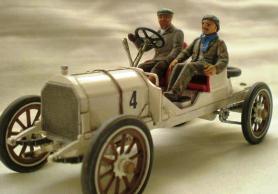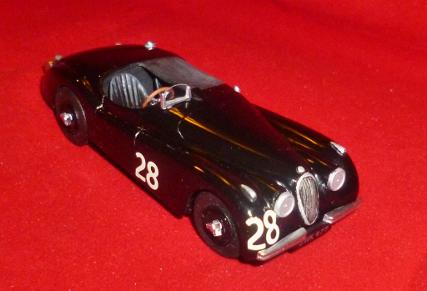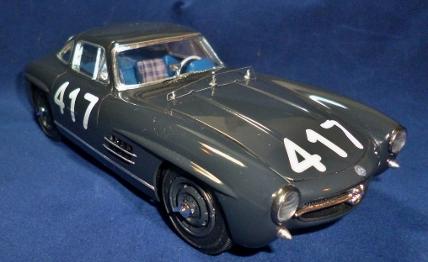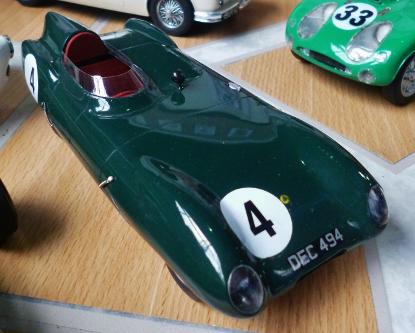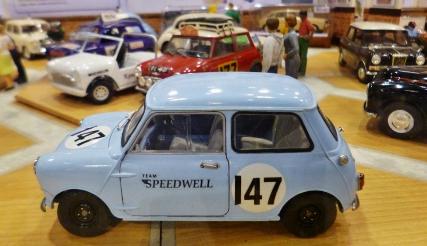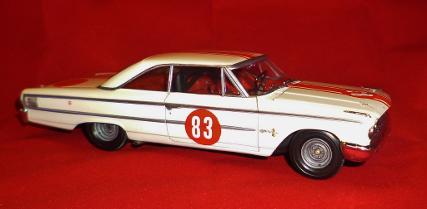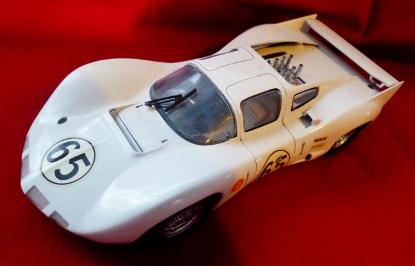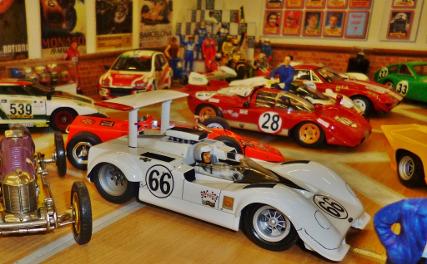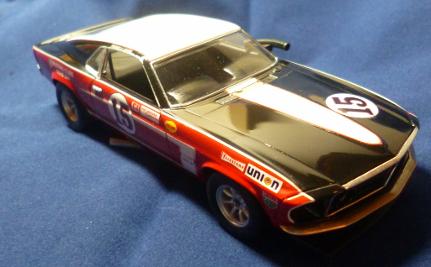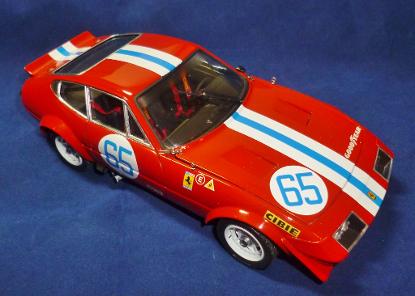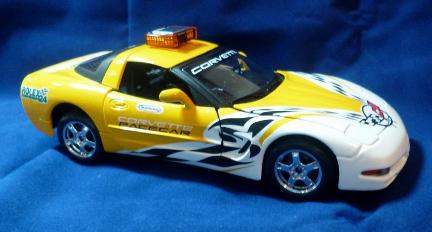The Sports and Touring car Collection
Sports-touring car racing is possibly the oldest form of racing motor cars. When the auto-mobile came into being it was closely followed by the idea of racing and very soon the cars people drove for practical reasons were also the cars they raced for fun.
In the early days of the motor car owners bought a chassis and had a body builder make a body to their personal requirements so it was perfectly feasible for the coach builder to make an open touring body, an enclosed sedan body and a light weight racing body which could be interchangeable on the same chassis.
Of course this sort of swapping and changing came with it's own drawbacks and specialised sports and racing cars developed. Competition evolved in a variety of challenging forms but racing the cars as they came from the factory has always been the form of motor car racing that is the easiest form for the ordinary observer to relate to. But even Sports and touring car racing fragmented into different forms including NASCAR, GT, BTCC, WSC, CanAm and many other categories.
In this collection we will try to show the evolution of these forms of racing as well as the broad range of model car kits available to the model enthusiast.
Motor racing started as soon as there were two vehicles to compare against each other , but it took some time for designers to start on a path that would separate the normal road cars from 'racing' cars. The drive to be better than the other competition and establish sales did push the automobile manufacturers to introduce new ideas. The steering wheel, shaft drive, honeycomb radiator, gate gear change, over head cam shafts and many more developments came from the need to go faster and longer than any one else.
By the time of the Gordon Bennett international cup races cars were already starting to be classified according engine power and vehicle weight. Races had classes for what were considered 'sports' cars, touring cars and 'light cars' (latter known as voiturettes). After the 1903 Paris-Marid race ended in a string of disasters racing was almost universally band on public roads and the split between out and out racing cars, for circuit racing, and sports and rally/trials cars became inevitable.
1904 Mercedes
1/32nd scale Airfix conversion.
In 1900 Emile Jellinek, wealthy diplomat, motoring enthusiast and Daimler owner/race driver, joined the Daimler Board of Directors and encouraged them to start building high performance "sports" cars. To get them to agree he places an order for 36 cars, but-insists on a change the name! to…..‘Mercedes’.
Wilhelm Maybach was put in charge of the new model, introduced in 1901 at the Pau G.P., IT FAILED. But nearly all the races during Nice Week held soon after were won by Mercedes cars.
Our model is as raced at the Gordon Bennett race of 1904. After a fire at the factory the official Mercedes team cars were all lost. Wealthy customers loaned their own cars which were hastily re-bodied but in all other ways remained much the same as when they left to roads. Mercedes still won the Gordon Bennett International Cup.
1906 Itala
1/32nd scale 'Shell' promo' kit.
Like many motor manufacturers Itala saw the benefits of competing in motor sports and started making very large engined racing cars In 1905. These vehicles had big engines a 14.8 Litre 5 cylinder model which won the 1905 Coppa Florio a year later winning the inaugural Targa Florio.
1907 saw Count Scipione Borghese driving a 7,433 cc, 35/45hp model, win the Peking to Paris motor race, by three weeks. This was backed up by a win in the Coppa della Velocita too.
1906 Rolls-Royce 'Light 20'
1/32nd scale Airfix conversion.
Between 1905 and 1907 Rolls-Royce 'light 20' cars raced in Ireland, the Isle of Man and the USA, often driven by C.S. Rolls himself. Light Twenties took second place in the 1905 Isle of Man Tourist Trophy race and won the 1906 running, thus enabling Rolls-Royce cars to gain an early reputation for quality and endurance. Rolls set a new record for the Monte-Carlo to London run in a Light 20 in May 1906 and the model also won various sprint races at Empire City Track, New York and Ormond Beach, Florida.
1913 A.L.F.A.
1/32nd scale scratch built model.
The A.L.F.A. company moved into motor racing soon after it was established. Their first major race being the 1911 Targa Florio. Drivers Franchini and Ronzoni competed with two 24hp models. Nino Franchini dropped out after an accident on the 3rd lap and Ugo Ronzoni retired his car, also on lap 3, because he was exhausted! A.L.F.A. offered it’s cars to the public built with exactly the same specifications as these race models.
The first real success came at the 1913 Parma Poggio-di-Berceto hill climb when Nino Franchini drove an A.L.F.A. to 2nd place overall.
Grand Prix racing on closed circuits grew steadily prior to WWI but the war had seen great leaps forward in engine and aerodynamic ideas, speed and construction became revolutionised. As countries created proper purpose built race tracks, Monza, Brooklands and Indianapolis being early examples, a new style of sports prototype cars also emerged. Their was a clear difference between the thorough bred Grand Prix car and the sports cars on the roads and specialised racing sports cars.
Racing was also a good way to attract tourism and trade so local authorities would close the public roads in places like Spa, Pau, le Mans and Monaco. The different demands of the purpose built circuits, street circuits and larger open road tracks tended to suit different types of racing cars. Differences were also seen amongst the competitors and teams involved. Rich gentleman owner drivers slowly gave way to more professional drivers signed on by the big companies. 'Racing' cars for Grand Prix became ever more expensive and specialised so that the more amateur and lesser funded drivers and firms raced the cars that were closest to production vehicles.
1927 3-ltr Bentley 'le Mans'
1/87th scale R&L kit, super detailed.
Bentleys engine designs were advanced, even revolutionary for the 1920’s. The cylinder block and head were made as a single casting to cut down on gasket leaks. They had Aluminium pistons and overhead camshafts operating four valves per cylinder. Even dry sump lubrication!
The 3-ltr car was proved on racing circuits and having won the le Mans 24hrs endurance classic in 1924, was every bit as good the European marques sports racing cars. But you often need more then being the best to win. So it was the Bentley suffered some terrible luck at le Mans in the following years.
In 1927, nothing was left to chance, yet a spectacular seven car crash involved all three of the Bentley teams cars. Could Bentley ever win at le Mans again? You bet they could.
1930 4.5Ltr Bentley 'Blower'
1/24th scale Heller kit, super detailed.
Bentleys engine designs were advanced, even revolutionary for the 1920’s. The cylinder block and head were made as a single casting to cut down on gasket leaks. They had Aluminium pistons and overhead camshafts operating four valves per cylinder. Even dry sump lubrication!
1925 saw a new 6ltr engine and backing from Woolf Bonato, a millionaire with money to burn. He took to racing the Bentleys himself and along with several well known figures they together became the legendary “Bentley Boys”. Although 1925 and’26 were poor years for results the 6ltr engine was developing well and the foundations were being laid for future dominance. Bentleys won the 24hrs du mans consecutively from 1927 to 1930.
1931 Mercedes SSKL
1/32nd scale Matchbox conversion.
The SSK chassis lost 200kg in weight after being bored through several times. This was typical of Daimler-Benz, and had already been applied to the Benz Tropfenwagen. Porshe’ successor, Hans Nibel, was happy to continue the Benz traditions. The engines swept volume remained unchanged, but the compression ratio was increased to 7:1. The new power output of 300hp was quite remarkable.
The legendary driving talents of Rudi Caracciola cannot be ignored. Having to buy and run the car himself when Works support ended following the Wall Street crash, he became the first non Italian to win the Mille Miglia.
1939 BMW 328
1/25th scale Heller kit
The BMW 328 was produced between 1936 and 1940. It made it's racing début at the Eifelrennen race on the 14th of June 1936. They were Class winners in the 1938 Mille Miglia and did extremely well at le Mans in 1939 where this car, driven by Willi Breim and Rudolf Scholtz, finished in 9th place overall.
This elegant well-balanced roadster, designed by Fritz Fiedler, combined low weight with an 80hp engine so performance was very good. Cutting-edge suspension gave good road holding and drivers liked the car.
464 of this classic roadster were built before production ceased in 1940.
1939 Bugatti Type 57 'tank'
1/24th scale Profil24 kit
The Type 57C based “Tank” won the 1936 French Grand Prix, and the 1937 24 Hours of Le Mans. Having conquered the greatest endurance race Ettori Bugatti said there was no need to continue in sports car racing, they had proved they are the best, and shut the program down.
However Bugatti’s son, Jean, (aided by Jean-Pierre Wimille) persuaded his father to have another go at le Mans for 1939. Bugatti laid down the rules though and said “only one car can win, so you can only build one car”.
The 1939 running was the 16th Grand Prix of Endurance at le mans. It would be the last for 10 years as the race planned for June 1940 was called of due to the invasion of France. Le Mans 24hr endurance racing didn’t return till 1949.
From the 1950's onwards new forms of sports racing emerged rapidly. Simple production sports car, specialised sports car, prototype and 'stock' car racing would grow into NASCAR, saloon car and touring car racing as well the CanAm series and fantastic races such as the Carrera Pan America joined the Targa Florio and Mille Miglia to draw crowds and drivers from all around the world. Many of these would give birth to proper world championships.
More than any other country Great Britain had a huge growth of 'do it yourself' car enthusiasts joining clubs and setting up meetings on old war time airfields. Some of these, such as Silverstone, went on to be world famous while others fell into disuse over the years. The 500cc club was born providing drivers with the first step on the ladder and in a most affordable way. Lotus and Cooper produced affordable sports cars and the scene was set for a boom in British motor sports.
1949 Porsche 356
1/25th scale Revell kit
After the War Porsche rebuilt and Ferdinand "Ferry" Porsche created a mid-engine, tubular chassis 356 prototype called "No. 1", in 1948. This was refined into a completely new ‘unibody’ monocoque style chassis body shell designed by Erwin Komenda. The new 365 had an air-cooled, four-cylinder, rear-engine, rear-wheel-drive system much like the Porsche Senior designed VW Beetle.
The first road going 356 was delivered in Austria on the 8th of June, 1948, and the owner wasted no time in entering it in a local race in Innsbruck were it took a class win. Successes continued and a class win was achieved at Le Mans in 1951. By 1954 the development of the 365 saw less and less shared VW parts, aluminium body panels to save weight and cabriolet body work. It soon gained a reputation for speed and handling and became much sort after racer, and sports road car, in the USA.
Production of all body styles continued until 1965, around 76,000 had been produced.
1950 Jaguar XK120 OTS “JWK977”
1/43rd scale Grand Prix Models kit.
Jaguar XK120 JWK977 was one of six alloy bodied cars raced by the works team. In fact, all the original run of XK120s were alloy bodied, not just for lightness but because it was actually easier to procure than steel which was still “rationed” post war. Demand for the car caught William Lyons by surprise, he had envisaged at most a single years manufacturing life, so the aluminium body was coach built in the traditional manner. Such was the demand that in 1950 a switch was made to a quantity production pressed steel shell, although they retained the aluminium doors, bonnet, and boot lid.
1952 MG TC
1/32nd scale Matchbox kit, super detailed
With the second world war finally over MG was anxious to return to making sports cars, and set to work upgrading the TB. Largely based on the 1939 TB, the TC had a few subtle differences.
US service men having experienced the nimble little cars of Europe during the war wanted them back home and a boom in sports cars occurred in the US, MGs became something of a cult vehicle. UK government Post War regulations promoted exports to bring money into the country and, as the US had more money to spend on entertainment or luxury than the UK, the Nuffield organisation made some changes to the car to appeal to that market. In fact the Sports Car Club of America blossomed from one branch of the M.G. Car Club!
1953 Pierre Barbot Citroen 2CV Special
1/24th scale Heller kit conversion.
After the second world war Citroen revived it's small car programme with the 2CV. A cheap, economical, reliable and practical mode of transport was the aim; racing them was never entertained.
However, affordable reliable cars often turn out to be ideal for racing, like the Mini for instance. Pierre Barbot was a talented engineer and also a visionary when it came to his competition special. Take the 375cc 2CV and reduce the engine capacity to 348cc in order to compete in the under 350cc classes.
Between 1951 and 1953 Barbot built and refined his vehicle until it was ready to race, It won its class at the Bol d'Or and followed it up with nine international records for speed, time and distance later the same year. It also launched a very young Jean Vinatier on the road to endurance rally stardom.
1954 Bristol 450
1/24th scale scratch built model
The Bristol Type 450 sports car racing prototype model was born out of the abortive 1952 ERA G-type F2 car. The cars were constructed specifically to race at the 24 Hours of Le Mans. Bristol were able to make use of their aviation expertise and wind tunnel facilities to produce a twin-finned fixed head coupé, and an open sports car.
1954 le Mans 450 #33 of Tommy Wisdom-Jack Fairman finished 8th overall, 2nd in class behind the sister #35 car of Peter S. Wilson-Jim Mayers and ahead of another sister car #34 driven by Mike Keen-John Line. Bristol won their class and the team prize in 1954 a feat they repeated in 1955. In addition to its le Mans successes, the Bristol 450 also took a number of outright speed records in 1953 for the 2ltr class at the Montlhéry circuit.
1955 Mercedes 300SL Mille Miglia class winner
1/24th scale FROG kit conversion.
Mercedes created the 300SL road sports car out of it's success with their 300SL racing sports car. Just as the 300SL racing car was never expected to be a road going car the road going 300SL "Gullwing" was never expected to become a racing car.
Just before the 1955 Mille Miglia Daimler-Benz board decided they would support the use of their new road going sports car and three of them entered the race. If the record breaking drive of Stirling Moss in the 300SLR was phonomenal the John Fitch's drive to finish just 84 minutes behind him in, a road car with the bumpers taken off, must be considered as equally astonishing.
1955 'D' Type Jaguar
1/24th scale Lindberg kit
20 years after Bentley had dominated Le Mans Jaguar were giving Britain honours at the historic race once again, and it was an old 'Bentley Boy', Walter Hassan who was running the Jaguar sports car development programme.
Hassan and Jaguar founder William Lyons started taking race wins with the XK120 and developed it for Le Mans as the XK120C, or C-type Jaguar (one of the first cars to feature disc brakes). C-Types won Le Mans in 1951 and 1953, but something new would be needed for 1954. Enter the D-type.
The D-Type borrowed heavily from contemporary aircraft construction. A space frame chassis construction was dropped in favour of a central stressed skin aluminium monocoque chassis (8 years before the Lotus25) with a tubular front sub-frame to which was bolted the engine, steering gear and front suspension. The D-Type provided Jaguars third Le Mans victory in 1955, in the hands of Mike Hawthorn and Ivor Bueb. In 1956 and 1957 Jaguars honour was upheld by the Ecurie Ecosse teams D-types after Jaguar works had given up on racing.
1956 Aston Martin DB3s
1/24th scale Merit kit
The DB3s was Aston Martin’s replacement for their rather heavy DB3. Largely based on the DB3 the DB3s prototype was débuted at Charterhill in May 1953 were Reg Parnell drove the DB3S to overall victory beating an Ecurie Escosse C-Type on the way. In fact the car was so successful in 1953 the only race it didn’t win was the le Mans 24hrs!
11 works cars and 20 customer cars were built making a total 31 DB3s cars. This includes the two works fixed head coupés DB3S made for le Mans 1954 where it was felt the enclosed body work would be more aerodynamic. Unfortunately they were actually less stable than the open cars and both of them crashed out of le Mans, later both the coupé’s were converted to open body form, although three customer coupés remained unchanged. 1954 wasn’t such a good year to the Aston Martin team but in 1955 Peter Collins-Paul Frère #23 DB3s came second at le Mans splitting two ‘D’ type Jaguars and giving Britain a 1-2-3 success at the great race.
1956 Lotus 11
1/24th scale Merit kit.
1/43rd scale renovated 'Dinky' model.
1/24th scale Merit kit restoration.
The Lotus 11 has one of the most elegant of body shapes. A Frank Costin creation it truly looks as aerodynamic as any car could ever be, though it never saw a wind tunnel. Colin Chapman's inspiration for the 1956 season, the Eleven was a serious case of form following function. A tubular space frame chassis with De Dion rear axle and Girling disc brakes, the standard version, called the Le Mans, boasted a 1500 cc Climax engine. The car weighed only about 1,000 lb, fully loaded.
Other Versions were the club, for 1100cc racing featuring a Climax engine, and the Sport, for 1200cc racing utilising a Ford engine; both featured a live rear axle and drum brakes.
In the 1956 season the Elevens scored at least 148 race wins. At the 1956 24 hours of Le Mans the quick and agile Eleven proved it could also last the distance. Reg Bicknell & Peter Jopp drove their Eleven to finish seventh overall and win the 1100cc sports car class.
They went even better in 1957 with new wrap around windshield cars, the American crew of Mackay-Fraser and Chamberlain recording an average speed of 99.08 mph on their way to 8th overall. In fact all four team cars finished. Walshaw & Dalton finished 13th, Hall & Allison were 14th & 1st in 750cc sports class, (and averaged 90 mph to win index of performance) while Masson & André Héchard finished 16th overall. Also a specially streamlined Eleven, modified by Costin to have a bubble canopy over the cockpit, was driven by Stirling Moss, and at different times "Mac" Fraser, to set a series of closed track world speed records at Monza. The 1,100cc car covered 100km at 135mph with a fastest lap of 143 mph (230km/h).
For the seasons from 1956 to 1958 the Eleven reigned supreme in its class and even in 1959 it could still hold it's own. Later some of the cars were fitted with a closed body and gullwing doors to race in GT specifications.
1958 Lotus Seven
1/24th scale Tamiya kit conversion
The Lotus Seven was the design after the Lotus 6 but the designation of Lotus 7 had been used for a car previously made for Trials competition. To differentiate the designs the Seven was written instead of given its numeral form. This made the seven unique in Lotus history and over the years made the Seven a brand in it’s own right.
The differences between the well funded teams like Ferrari and Mercedes were in stark contrast to the small British firms of Lotus and Lister, while Ford and Porsche were about to emerge as proper contenders which would make Bentley and Jaguars domination of le Mans look rather ordinary.
In Britain the British saloon car championship and Grand Touring series emerged and the 500cc club had all sorts of innovative designs put forward in its drive to find the best balance between weight, engine power and aerodynamics. Cooper, Lotus Brabham and more became more and more competitive as the Germans and Italians lost ground.
The NASCAR Grand National series was developing nicely in the United States, and from a series run mostly on dirt ovals, having only had it's first 'paved' circuit in 1950, by the end of the 1960's was almost entirely run on permanent asphalt tracks. The cars that had once been the upgraded road cars were still the mainstay of the series but they were now from a definite 'muscle car' league rather than anything a family might travel in.
1960 Austin Se7en "Team Speedwell" Mini
1/24th scale Tamiya kit.
The Mini, probably the best-known car in the world, was launched in 1959 as the Austin Se7en and Morris Mini-Minor. The Austin label denoted the most basic and cheapest model (harking back to the days of the old Austin Seven model ethos) with Morris models being a little more sophisticated. Wolseley (Hornet) and Riley (Elf) versions would be added to the range to take the car more up-market, then the Cooper models made gave the speed edge that propelled Minis onto the race tracks and rally stages of Europe, and later, the world.
But there were other tuners taking the Mini onto racing circuits and probably the greatest of them at the time was John Sprinzel's Speedwell outfit.Backed by the driving talent of Graham Hill and John Sprinzel the "Team Speedwell" cars became winners at home and abroad.
1961 Jaguar 'E' type
1/32nd scale Airfix kit.
March the 16th 1961 is one of the most famous dates in Jaguar Chronology. It was then that the 31st Geneva Motor Show opened its doors to the public and there could be no doubt that the star of the event was Jaguars new 150 mph E-type sports car which was unveiled.
John Coombs owned a successful garage business. He began his racing career in 1951 in 500cc racing and even led Stirling Moss in one race. he drove a Cooper Bristol and Lotus XI but increasing business commitments led him into preparing the cars for others. Coombs entered cars for some of the biggest names in British motorsport. Jack Brabham, Graham Hill, Roy Salvadori and Ron Flockhart all drove Coombs Jaguars.
1961 Maserati T61
1/24th scale Aardvark kit.
The Maserati Tipo 61 was produced through 1959 and 1960. It was a bold departure from Maserati design custom. The spaceframe chassis itself was constructed of around 200 small steel tubes, earning it the nick-name, 'Birdcage' Maserati. Rack-and-pinion steering was standard with the front suspension via wishbones while the rear was supported by a DeDion axle. Disc brakes were used all round. All of which gave the car a reputation for being easy to drive. With its low weight, strength and great power to weight ratio it was highly competitive, and the winning record of the cars speaks for itself. Victory in the 1960 Cuban Grand Prix and the 1000km of Nurburgring, as well as Gus Audrey and Roger Penske capturing class championships in 1960 and 1961 SCCA racing seasons.
1962 Jaguar MKII
1/24th scale Tamiya kit
As soon as the Jaguar Mk II was released, it attracted the attention of the racing world. And with good reason; the Mk2 went on to totally dominate saloon car racing all over the world in the early sixties. It earned its first outright win in the hands of Sir Gawaine Baillie in 1960 at Snetterton. Over the winter of 1961, John Coombs mechanics built up “BUY 12”, or more accurately stripped it down, for racing.
1963 Ford Galaxie 500 'R'code BSCC
1/25th scale AMT kit
The 1963 Ford Galaxie 500 was huge car, and not just in engine capacity. These cars were 30in’ longer and 13in’ wider than 3.8 Mk II Jaguar, and that wasn’t a small car by British standards. They needed the advantage of horsepower too, 400hp over the Jaguar’s 220hp, as the Galaxie 500 was around 300Lbs heavier than the Jag’s.
Although Ford commissioned approximately 210 ‘Lightweight’ ‘R-Code’ 427 Galaxy 500s from Holman & Moody, of Charlotte, North Carolina, USA, only three cars were destined for the BSCC.
John Willment Automobiles team manager, Jeff Uren, placed a call to 1958 BSCC Champion “Gentleman” Jack Sears, a very popular driver. Not just a veteran saloon car racer with multiple race wins and championships, Sears also had class wins at the le Mans 24hrs and the Daytona 24hrs too, clearly a highly adaptable, dependable and successful driver any team would be glad to have on their staff. Jeff Uren explained the new team had acquired the Galaxie and a couple of Cortinas. This was important as the Championship's under 2ltr class winner was to get equal points to the overall winner so even if the Galaxie was out of action then the Cortina still kept the driver in the championship standings.
Sears agreed and the rest is history.
1963 Ferrari GTO
1/24th scale Airfix-Gunze Sangyo kit.
The 250 GTO could be said to be a response to Jaguars new E-type launched in 1961. Ferrari sales manager Girolamo Gardini saw the unveiling and returned to the factory telling anyone he could get to listen that “They are going to beat us with their new GT’. Once Ferrari recognised the seriousness of the situation he set up a team to build a new GT car capable of taking on the new threat. Ferrari is often quoted as saying “Aerodynamics are for people who can't build engines” He must have regretted saying it when he saw the 250GTO.
To gain homologation into the FIA's Group 3 GT Car category Ferrari should have built at least 100 examples of the car. Only 39 were actually made. Ferrari maintained the argument that the GTO was an evolution of the SWB despite the fact that the cars shared very little in common. But it was a success and won the over 2Ltr class of the FIA's GT manufacturers cup in 1962, ‘63 and ‘64.
1964 Ferrari 250LM
1/24th scale Academy kit
Ferrari used the mid-engine layout with the 250P prototype and achieved a degree of success, 250Ps finished 1st and 3rd at Le Mans in 1963. The choice to use that car as a base for the 250LM seems logical. The 250LM is another adaptation of the 250 family, except that it isn’t. It is well known that Enzo pulled a fast one to get the GTO homologated, when he tried the same trick with the 250LM he was firmly told off. 100 built units was the criteria for homologation; Ferrari built just 32. The car had to race in the prototype classes and never really had the success it should have.
1964 Lotus Seven Series II
1/24th scale Tamiya kit
The Lotus Seven was in production from 1957 to 1972; after that it remained on sale under the Caterham and latterly as Westfield. The important thing is that Colin Chapman designed a car which in terms of longevity of production out lasts almost all road going sports cars. Several factors contribute to this achievement, a 0-60mph time that started at under 5sec’s (and only come down), a top speed in excess of 100mph in a responsive chassis with good handling characteristics that made it fun to drive. Chapman himself refer to the ‘Seven’ as a “'four wheeled motorbike”, and it still gives the same thrill today as it did the day it was launched.
1,350 Series 2 Sevens were sold and they went worldwide racing on circuits from Aintree, Liverpool, to Liverpool, New South Wales, Australia.
1966 Ford GT40
1/24th scale Fujimi kit
In the early 1960’s Ford shook off its entrenched, staid approach to car design and embraced a new policy under the 'Total Performance' banner. As part of this strategy, the company decided it must win the Le Mans 24 Hours race. After failing to buy Ferrari Ford turned to Lola & the Anglo-American derived GT40 gave Ford four victories in a row at the Sarthe circuit between 1966 and 1969.
1966 Chaparral 2D
1/24th scale Monogram kit
Jim Hall and Hap Sharp formed Chaparral Cars in 1962 and drove/managed their cars through until 1970. The company was named after the roadrunner, a fast-running ground cuckoo (hero for a generation of cartoon lovers) that is actually called a Chaparral.
The 2D was the first closed cockpit Chaparral the earlier cars all being the open cockpit cars. It was designed for endurance racing and competed in the 1966 Le Mans and won Nürburgring 1000 km in the hands of Phil Hill and Joakim Bonnier.
John Rhodes 1966 Cooper Works Team Mini
1/24th scale Tamiya kit.
Cooper; 500cc champions, F1 champions, and so synonymous with the Mini it is still the go-to version of the BMW MINI to this day. If you can’t think Mini without thinking Cooper then you are clearly not a motor racing fan. If you were, then Mini would mean Paddy Hopkirk, Timo Mäkinen, Rauno Aaltonen, and, John Rhodes.
The great “Smoking John Rhodes” had a fantastic record with the Cooper works Minis. This model proves an interesting addition to the story of the Mini; a story some think may never have been so celebrated had it not been for the sporting prowess and exciting driving experience of the Mini Cooper range.
1967 Ferrari 330-P4
1/24th scale Fujimi kit
The 330 P4 debuted in 1967, the culmination of a development dating back to 1964. Ferrari may have missed a beat when Cooper turned F1 back to front but he was not going to make the same mistake in sports cars too. Ferrari had the mid-engined Dino 246 SP competing on track in 1961. Then came the Ford merger talks in 1963 and the subsequent threat from the GT40. Ferrari were already campaigning the 250P by then and put considerably effort into its development. Ferrari won the last ever le Mans for a front engine car in 1962 (330LM spyder) and the first for a mid engine car in 1963 with the 250P. Such dominance was shown across most of the race tracks of the world and Mr. Ferrari was determined that it should continue.
1967 Lotus-Ford Cortina
1/24th scale Scalekraft transkit on Esci base kit.
The transmission & four-speed gearbox, comprised of components modified by Colin Chapman at Lotus, who was allowed to undertake more than just an engine transplant. Lotus got the Cortinas from Ford in kit form. They had to put all the panels together themselves, replacing opening panels with light alloy versions. This system also allowed them to amend items as required in their quest to upgrade handling, as well as the engine power output. Much of the suspension was changed, particularly at the rear, and alloy castings helped lighten many areas of the car. Internally the project was known as the Lotus 28.
Team lotus entered racing in the classic white and green colours instantly recognisable the world over. They also supplied cars to other race teams the most notable of these being the red and gold cars of Alan Mann racing. The original contract of 1000 examples was sold out in no time and the project tie up was so successful it continued into the MKII Cortina as well.
Cortinas raced extensively in Britain becoming legendary in the hands of Jim Clark, Graham Hill and many others. They won from Bathurst to Brands Hatch and remain firmly fixed in the minds of 'tin top' lovers the world over.
1968 Chaparral 2G
1/24th scale Acedemy-Minicraft kit.
Jim Hall built some of the most innovative racing cars the world has ever seen. His studies in aerodynamics and ground effects pre-date Colin Chapman's and he was at the forefront of composite materials usage and vehicle data collection of suspension movement and geometry changes under loads and at different speeds.
The 2G never really attained the results it should have as when it was running it had great pace often battled for the lead and podium positions. All too often reliability cost the team points when the cars broke down, usually in the engine department.
1969 Lola T70 Mk3b
1/24th scale Roaring Replicars kit.
The Lola concern has made cars for almost every form of motorsports but it has had the most success in the world of sports car racing. Introduced in 1965 the T70 was similar to the GT40 (but without a roof), because the GT40 owed much of it’s design to Broadley’s 1962 LOLA MK6 GT sports coupe. Careful ‘weight engineering' meant that the T70 spyder was lighter that the Ford GT40 and, when mated to the Traco Engineering built 5.9-litre V8 Chevrolet engine, and Hewland’s brand new LG 500 gearbox, it was faster than any contemporary F1 car.
1969 Ford Mustang Boss 302 'Trans-Am'
1/32nd scale Hornby kit.
Ford's Mustang reached it's 50 year anniversary in 2014 and many people are looking back over the range that has not only been a popular car on the roads but also a star of the screen and the track.
One of the track stars was the Boss 302, introduced in 1969. It won the first round of the Trans-Am series that year but ultimately fell short of the goal that year. In 1970 Parnelli Jones took the Bud Moore engineering team to the Trans-Am title and the Boss 302 took its place in history.
Formula one became more safety oriented and professional in the 1970s, the deaths of so many drivers through the 1960s had affected more than those inside motor sports. Jackie Stewart championed the cause for the drivers and the awarding of the only posthumous world championship to Jochen Rindt brought the sport to a new level of scrutiny. The deaths of Jim Clark, Bruce McLaren, Jochen Rindt as well the awful crashes of Stirling Moss and Graham Hill made everyone conscious of how dangerous motor sport was, it was covered more and more in the newspapers and on Television.
Little by Little Formula one was dragged into a new professional world and the other forms of motor sport had to follow suit. The era of driving multiple forms of car in the same race meeting drew to a close as the different disciplines of motor sport saw cars became ever more powerful and specialised. Turbo charging was about to make an impact in Formula one, sports cars and Rallying. The supposedly cheaper forms of motor sport would start to move out of the reach of the amateur and Rally, GT and Touring car Championships became highly organised, nationally and internationally.
In the United states NASCAR was about to move into a new era when the R.J. Reynolds Tobacco Company became title sponsors of the series which would be known as the Winston cup for the next three decades. As part of the negotiations between NASCAR and RJR the points system was revised and by 1975 all races had the same points values regardless of distance or duration so drivers had to compete in all the races if they wanted a good shot at the title. To compensate the number of races was reduced, viewing figures continued to rise and in 1979 the Daytona 500 became the first stock car race televised from start to finish.
1/32nd scale Matchbox kit.
A development of the enclosed 917, which gave Porsche their first wins at le Mans in 1970 and 1971, the spyder 917-10 was run in the North American Can-Am championship, driven by Jo Siffert in 1971 and later in 917-20 and 917-30 development versions in Can-Am & Europe's Interserie until the mid-1970s. They were powered by by turbos and normally aspirated engines.
The highly specialised 917 series marked a watershed for Porsche who felt they had strayed to far away from their roots and would return to their instantly recognisable sports car shape with the 935 series which borrowed parts from the 917s
1972 Matra 760
1/24th scale Fischer kit
Matra found they could apply their technology, such as aerodynamics, to motor sports, so in 1965, took over the small René Bonnet sports cars co. (whom they had been providing glass-fibre bodywork to) and turned it into a world beating racing outfit in F1 and Sports cars. Matra enjoyed considerable success in F3 and F2 in the mid-1960s. In 1968 the company entered F1, alongside Tyrrell, running Matra MS10’s driven by Jackie Stewart.
In 1969 Matra focused efforts on the Tyrrell team (renamed Matra International) and won both drivers and constructor's championships. By 1972, Matra was giving priority to F1 and cut down their endurance-racing to just "le Mans". Matra found themselves favourite for the race having entered four cars all especially constructed and designed for "Le Mans". One M660 and three brand new M670's. The Pescarolo-Hill 670 won!
1973 Ferrari 365GTB/4 "Daytona" competizione
1/24th scale Italeri kit conversion
365 GTB/4 (365cc per cylinder with 4 over head cams), isn't a very evocative as a name and the press soon christened the design the “Daytona”. This unofficial title is said to be in honour of Ferrari's 1-2-3 victory in the 1967 Daytona 24-Hour race and although never used by the factory is the more commonly used name for this car.
They hold records in SCCA racing, have over 200 IMSA Victories, class wins at le Mans and 4 consecutive victories in the Daytona 24hrs race. the Fairlady 'Z' series has won the Safari Rally outright 7 times and has many rally podiums to accompany that record.
1976 Porsche 935-76
1/32nd scale Matchbox kit
Introduced in 1976 for FIA Group 5 racing the 935 is an evolution of the Porsche Carrera RSR 2.1 turbo prototype which did so well in the 1974 le Mans 24hrs placing 2nd overall.
Porsche customers bought the 935 series in droves and it became a huge crowd pleaser being so easily identified with the Porsche 911 they saw on the roads. The FIA World Championship for group 5 manufacturers was won at the last race after Jacky Ickx, Jochen Mass, Rolf Stommelen and Manfred Schurti battled all season long with the BMW 3.5 CSLs.
The 935 series would go on to win more races all around the world including le Mans in 1979.
1977 Lancia Stratos Grp.5 'Silhouette' racer.
1/24th scale Airfix kit
The Stratos is known the world over for it's prowess in Rallying. Sandro Munari and Bjorn Waldegard drove the Stratos to World Rally Championship victory in 1975, '76 and '77. The Stratos also won the 1974 Targa Florio driven by Gerard Larrousse and the 1981 'Tour de course Automobile' in the hands of Bernard Darniche; not forgetting 4 victories in the Monte Carlo Rally.
But the Stratos also ran in Group 5 racing where it won the 1976 Giro d'Italia. The V6 turbo engine developing over 560hp in a car weighing just 850kg.
1977 Ferrari 365 GT4 BB
1/24th scale kit
Only when the 365 GT4 BB came onto the scene did Ferrari road sports cars move to the mid-engine layout. First unveiled to the world at the 1971 Turin Motor show the 365 BB didn’t make it to the sales rooms for a further two years. When it did it retained much of the look of that P6 show car, including the very ‘70s ‘pop up’ headlights. Leonardo Fioravanti was the designer behind Ferrari's part of the car but the body shape was drafted at Pinninfarina. The beautiful lines of the bodywork flowed over the wheels, cabin a powerful flat 12 engine. The ‘look’ was something very different from any Ferrari that had gone before, if the new car shared a numeric designation with it’s Daytona predecessor, that was all it shared. The 1977 le Mans 24hrs garnered the team 16th place driven by Francois Migault and Lucien Guitteny.
The 1980s were the years when Motor Racing started to become truly global, not in terms of races, there had long since been series with races all over the globe, but in terms of publicity. F1 coverage had become standard Sunday afternoon viewing and other forms of racing were catching on to the ideas of a fan base, publicity and the lucrative sponsorship deals they brought. The sponsorship deal in NASCAR meant the Winston Cup series continued to flourish and the 'Winston Million' became a feature.
BTCC started appearing on British TV and with the advent of satellite TV was available all over Europe. However, the BTCC took a while to catch on to how their rules conflicted with fan based entertainment. Only in BTCC could the Ford RS Cosworths win the races and a lowly Vauxhall Astra actually win the championship. BTCC started changing in many ways and very rapidly.
Germany's equivalent the DTM came into being and would soon rival the BTCC in attracting the best drivers from across Europe, in fact these two series were so competitive that the FIA instigated the fledgling World Touring car Championship with a single season 1987.
Professor Sid Watkins demands for medical standards and F1 safety started to expanded into the other forms of racing. By the end of the 1980's it wasn't thought of as F1 racing safety but 'Track Safety' and all forms of motor sports were required to meet medical and safety standards. If that wasn't enough races could be in jeopardy if there wasn't a hospital of a high enough standard within a reasonable helicopter flight, something often beyond the control of organisers and promoters.
New FIA groups A, B and C replaced the 5 groups in motor racing. Group A was strictly regulated to keep cars close to their production equivalents and keeping costs down with the aim of ensuring a large number of privately owned entries in races. Group B was almost the exact opposite with exotic materials, unlimited power and no minimum weight; great for the companies that wanted to compete for outright victories. But it quickly led to prohibitive costs and almost undrivable cars, soon dubbed the "Killer B's", until the FIA suspended these rules in 1986. Group C had similarly few restrictions on chassis and engine development but did have strict rules regarding weight and fuel loads.
1985 BMW 635CSi
1/24th scale Tamiya kit
The BMW 635 CSi was developed extensively for group A racing, which was actually the closest to stock cars at the time. Weight was trimmed down to 1,185kg and it was powered by a 3.5Ltr single overhead cam engine which produced an amazing 300 horse power.
Schnitzer were founded in 1967 by the brothers Josef and Herbert Schnitzer. They are one of the most successful campaigners of BMW cars over many decades now and their record is extensive.
1986 Chevrolet Monte Carlo SS
1/24th scale Monogram Kit
Chevrolet ran the slope-nosed Monte Carlo SS from 1983, but the car's chopped-off roof line meant that air spilled off before it could settle over the boot lid to provide stabilizing downforce. If the car was going to become competitive with Ford’s T-Bird, it needed a new rear end. By simply adding a larger shaped glass rear window the coefficient of drag was lowered from 0.375 to 0.365, and finally the Monte Carlo had aerodynamic stability on a par with the Ford. The Monte Carlo SS started winning and just went on winning. It took 5 consecutive manufacturers cups and won 95 out of 183 races between 1983 and 1989. It was the longest running and most successful NASCAR model to that time.
1987 Jaguar XJR-8 lm
1/24th scale Hasegawa kit
Jaguar had no direct involvement in racing since rule changes had made the 'D' type obsolete after 1957, but they did support customers with 'E'-types, MKIIs and XJS' in a variety of motor sports. These were production cars that were sporty and well suited to racing, not thoroughbred racers. In 1983 a new race programme was started. Group 44 were supported with V12 engines for the Fabcar-built XJR-5 in the IMSA series and TWR developed the XJR-6 for the WSC. For 1987 Three cars were prepared by TWR for Le Mans but mechanical problems stopped any chance of success. But it would not be long before Jaguar were winning again.
1988 Jaguar XJR-9 IMSA
1/24th scale Hasegawa kit
The system of different chassis for IMSA and WSC stopped in 1988 when Jaguar chose TWR to cover both championships, building identical cars for both series, the XJR-9. Designed by Tony Southgate, it was an evolution of the XJR-8. Different variants of the XJR-9 would be designed for the differing race categories and situations . XJR-9LM would be specifically developed for Le Mans where high straight line speed and low-drag aerodynamics are required. This XJR-9 debuted at the 24 Hours of Daytona wearing Castrol livery, it qualified 6th on the grid and went on to win the race. It was a bit of a false dawn for the IMSA project and the XJR-9 was unable to win again until the final race of the season. But in Europe the car was having more success.
1988 Jaguar XJR-9 le Mans
1/24th scale Hasegawa kit
1988 and Jaguar once again win the Le Mans 24 Hour Race after an interval of 31 years. It was a statement to the world that, after a traumatic decade, the company was once again a force to be reckoned with on both road and track. At first Jaguars proved no match for the Porsche opposition. However, in 1987, the XJR-8 gave Jaguar its first ever world sports car championship victory.
Then, in 1988, no less than five XJR-9s were entered for the Le Mans; one was victorious and another came in fourth. It was the first Jaguar Le Mans triumph since 1957. A further victory followed in 1990 with XJR-12’s in first and second places, to bring Jaguars triumphs in the 24 Hour classic race to seven.
1989 Mazda 767b
1/24th scale Hasegawa kit
The Mazda 787B was designed for Group C sports prototype racing in the World Sportscar Championship, All Japan Sports Prototype Championship, the 24 Hours of Le Mans and IMSA GTP regulations. Powered by Mazda's R26B Wankel rotary engine the car lacked the overall pace of Mercedes-Benz, Jaguar, and Porsche, as well as Nissan and Toyota in the Japanese Championship; but were reliable and that allowed them to contend for their respective championships.
Because of its similar dayglow orange and green livery the 767B is often mistaken for the 1991 Le Mans winning 787B. Our model is 767B #202 chassis nr.002 sponsored by 'Charge' which finished 2nd in class and 9th overall in the 1989 Le Mans 24hrs race.
The 1990s saw the advent of "driver aids" in F1 and all the technologically advances trickled down to other formulas. Cars that had been much like their road car counterparts soon became ultra high tech machines covered in sensors and transmitting data each lap. Computers controlled the engines more and more and problems were diagnosed with a simple plug in unit rather than years of experience with a spanner.
Something had to give and in all areas rules were negotiated and re-negotiated as computer software hid inside other programs. The motor racing classes that were supposed to be affordable and fun became expensive, extremely secretive and tortuous for scrutineers. Many different rules came into effect to spice up the show, things like success ballast became a norm in BTCC while other forms of racing banned all electrical/computer aids and stayed true to machinery.
1998 Ford Taurus 'NASCAR'
1/24th scale Revell kit
The Ford Taurus was the best-selling car in America the for the previous five years, so when Ford looked to replace the Thunderbird for the 1998 Winston cup series the Taurus seemed the obvious choice. “NASCAR is all about racing cars that the fans can relate to”....and "the Taurus has been a winner with the public since it was introduced in 1986, and we expect it to be a winner for our Ford NASCAR teams." said Ford spokesman Rob Rewey. Ford were correct and the Taurus has now won over 100 cup races!
Jerry Nadeau deputised for an injured Lake Speed at the Melling Racing Team in 1998 and drove the cartoon network 'Scooby Doo' car. He was road racing driver and nobody believed he could adapt to the oval racing; he finished the season as 3rd best Rookie!
The new century found most branches of motor sports in turmoil. Initially it was the ecological issues for which the sport was being criticised and the financial expenditure simply mocked. But after the financial melt down cutting costs became suddenly just as important as making racing cars safer, more ecologically friendly and even recyclable!
A new DTM series was on the horizon in Germany, the Winston Cup series would soon be the Nextel Cup series as cigarette advertising was banned and in BTCC the new rules for 2000 would be rewritten again to make a Super 2000 set of rules from 2007. Then they changed again for the The NGTC (Next Generation Touring Car) specification aimed at cutting costs and making the series more sustainable.
By the end of the 'naughties' Diesel engined cars would be competing, and winning, at le Mans; Kers was a new (and hated) word, HANS wasn't a drivers name and Bentley was back at le Mans after a 68 year absence; and winning.
But if anyone was in any doubt about engineering excellence in motor car design the Germans were absolutely dominating le Mans.
2000 Chevrolet Corvette C5 pacecar.
1/24th scale Bburago kit
Chevrolet's 5th incarnation of the Corvette used the pinnacle of design and materials making it a truly cutting edge production car. Understandably it was in demand for official duties at race circuits and not long after put on new clothes and went racing itself in the for of the C5r which won it's class at le Mans two years running.
2002 Audi TT-R DTM
1/32nd scale Revell kit
Based in Kempten im Allgäu, Germany, Abt Sportsline races and tunes cars, their corporate motto, "From the race track to the street", clearly denotes their philosophy. They work primarily with Audi but also the Volkswagen Group related brands too- Volkswagen, Škoda, and SEAT.
The company took it’s biggest success, to that point, when Laurent Aïello’s Abt-Audi TT-R won the Deutsche Tourenwagen Masters title in 2002. This had come about as a result of Christian Abt winning the German Supertouring wagon championship title in 1999 with an Audi A4. Abt chose to run the new Audi TT-R for the opening season of the new DTM series. With little development time the team took a while to get on the pace; but they still won the title.
2002 Mercedes CLK-DTM
1/32nd scale Revell kit
The CLK (Coupe Leicht Kurz or Coupe/Light/Short) was first introduced in 1996. It marked Mercedes' first steps into the mid-sized coupe market.
When the International touring car championship was dropped the new Deutsche Tourenwagen Masters came into being and Mercedes were a big part of the development program. Unlike the old series the new DTM was to feature two door Coupés rather than the larger touring four door cars. AMG raced the two door CLK Coupé for the opening championship series. 2002 saw the second generation of the CLK it seemed logical to race it too. Driving the CLK DTMs in 2002 were defending DTM champion Bernd Schneider and the previous years runner-up Uwe Alzen. Also signed up were Marcel Fässler and Jean Alesi making his debut in DTM after retiring from F1.
2002 Opel Astra V8 DTM
1/32nd scale Revell kit
Deutsche Tourenwagen Masters was a new series started in 2000. Opels car of choice was the Astra G series Coupé. Or rather it was the basic look of the car as these cars are purpose built for racing in the DTM. Barely any parts made for the road cars make it to the race versions, as little as lights or door handles can be transposed from one to the other. Opel took second in the championship, with Manuel Reuter, in the inaugural DTM season. For the 2002 DTM season Opel fine-tuned their Astra V8 to make it even more competitive. A lot of work went into the bodywork, to ensure good aerodynamics. The 4.0L longitudinally mounted, naturally aspirated, 90º V8 with 4 valves per cylinder, DOHC and fuel Injection could now turn out nearly 500 hp.
Racing sporty road cars is sure to continue for as long as there is a motor car. Be it in NASCAR, DTM, BTCC, classes of the WSC or simple club racing on the local tracks of the world, people will want to test themselves and their vehicles. Of course the amount of money one has available will usually determine at what level you race, but for those who come to watch the action their loyalties will most likely lie with the brands and styles they themselves drive; and that will always make sports car racing attractive, and driving a sporty car a desirable activity.
